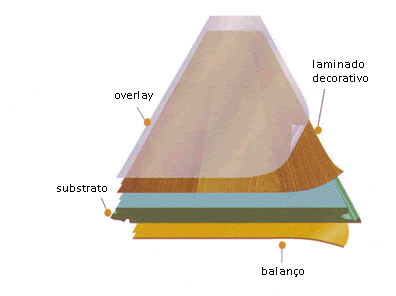O piso laminado é um dos principais tipos de piso de madeira. Ele é feito de árvores plantadas para fins industriais (pinheiro e eucalipto), que são fontes renováveis e recicláveis de matéria-prima.
Este tipo de piso é desenvolvido com tecnologia avançada e é utilizado em residências, lojas e ambientes corporativos.
Os principais diferenciais dos pisos laminados reconhecidos pelos consumidores são qualidade, praticidade, durabilidade, instalação rápida e fácil, além de conforto, beleza e proteção antibacteriana.
O piso laminado foi produzido pela primeira vez na Suécia em 1980 e importado para o Brasil em 1994. Foi imediatamente aceito no mercado brasileiro, e a produção nacional deste produto começou em 1999.
Atributos
O piso laminado de alta resistência oferece inúmeras vantagens. O produto pode ser instalado rapidamente sobre praticamente qualquer material, incluindo concreto, vinil, cerâmica, outros tipos de piso de madeira (superfície superior), exceto carpetes ou outra camada de piso de madeira flutuante.
Pisos laminados também são chamados de pisos de madeira flutuantes, pois não são colados, parafusados ou pregados no contrapiso, nem fixados no rodapé. Isso torna a instalação rápida e fácil de precisar.
Outro benefício deste para os consumidores é a fácil manutenção: requer apenas uma limpeza diária com um pano limpo e úmido (não encarcado). Ao contrário de outros pisos, ele não precisa ser envernizado ou polido.
O piso laminado não retém poeira nem sujeira e é útil para pessoas alérgicas; ele também fornece uma camada de isolamento térmico e acústico.
Resiste ao desgaste, manchas e impactos, garantindo também alto desempenho.
Interagindo com a Natureza
O piso laminado é feito de árvores plantadas para fins industriais. Esse processo de plantio respeita os padrões globais de proteção ambiental, como a certificação ISO 14000.
Além disso, as árvores plantadas são certificadas pelo Forest Stewardship Council (FSC) e pelo National Forest Certification Program (CERFLOR), e endossadas pelo Programme for the Endorsement of Forest Certification Systems (PEFC).
Isso significa que as árvores são cultivadas de acordo com os princípios de manejo florestal sustentável que buscam reduzir os impactos ambientais e promover o desenvolvimento econômico e social das comunidades do entorno das plantações e usinas.
Vale destacar também que os resíduos do processo produtivo são aproveitados, transformando madeira em energia para abastecer o processo de fabricação nas fábricas.
Composição do piso laminado
O piso laminado está disponível em tábuas, que são compostas de fibras ou partículas de madeira. Essas tábuas são feitas com padrões de grãos de madeira em suas superfícies e são muito resistentes à abrasão, o que garante durabilidade.
As tábuas são feitas em diversos acabamentos e tamanhos, o que oferece aos consumidores muitas opções de decoração.
As principais camadas do piso laminado são:
Camada superficial
- Camada de sobreposição ou desgaste – Esta camada de filme de polpa cristalina está impregnada com resina de melamina e partículas de óxido de alumínio, o que se torna altamente resistente a riscos e abrasão. Ela tem porosidade notavelmente baixa, o que torna a limpeza a seca e torna fácil de limpar, além de prático.
- Camada de padrão ou design – Esta camada decorativa de polpa é impregnada com resina de melamina, em uma variedade de padrões e núcleos para produzir um acabamento atraente.
Essencial
- HDF / HPP – Esta camada é composta de aglomerado de partículas de alta densidade ou fibra de madeira feita de pinheiros e eucaliptos plantados de acordo com padrões internacionais. Esta camada é usinada na lateral e na parte superior para criar um sistema de trabalho macho e fêmea. O núcleo é forte e estável, fornece uma conexão precisa entre as tábuas e resistência a impactos e cargas técnicas de móveis pesados.
Filme estabilizador
- Suporte – Esta seção é feita de folhas de celulose impregnadas com resina melamínica, o que proporciona estabilidade estrutural ao piso.

Abaixo segue o certificado de reconhecimento de qualidade do Ministério das Cidades (Programa PBQP-H) para cada empresa associada:




